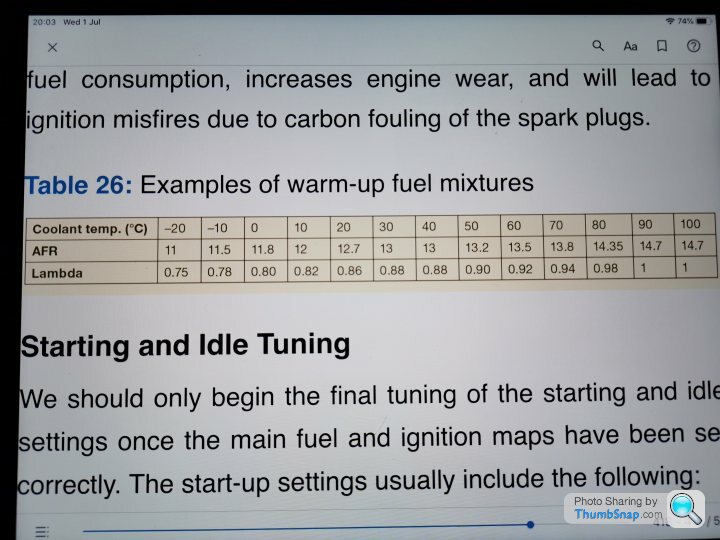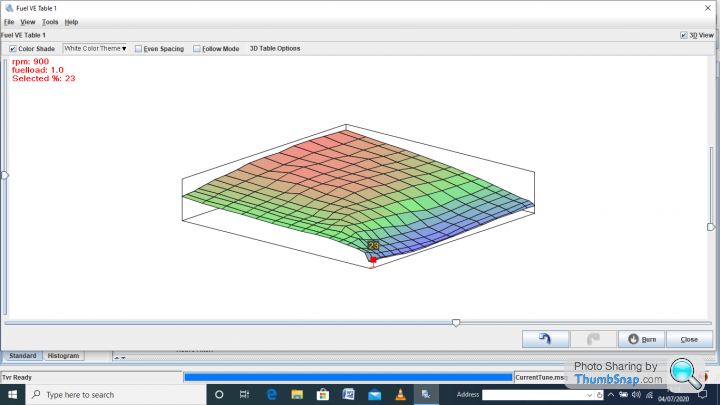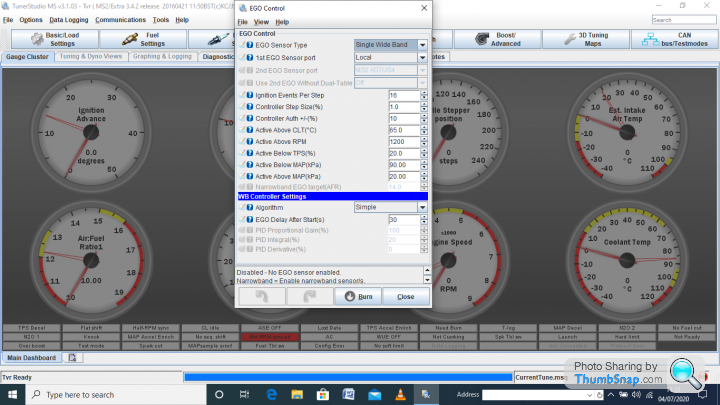Aftermarket Ecu warm up enrichment
Discussion
i have my car running really well on megasquirt but have one small problem during warm up enrichment.
The car starts well and runs well as it starts to warm up but when i reach around 75 degrees and my enrichment ends my engine will stall.
just before it stalls i witness the Afr going lean which is telling me it needs a slightly longer enrichment.
The problem is that in cold weather the running temps may creep as low as 75 degrees, which takes me back into enrichment.
Im happy my thermostat is functioning correctly.
its probably something ive just got to live with and may happen on the 14cux.
Picture enclosed to show the enrichment curve and the settings, my idle Afr is set to around 13.5.
The graph on the right is the plot the autotune feature uses to fine tune the graph for you and seems to work well.
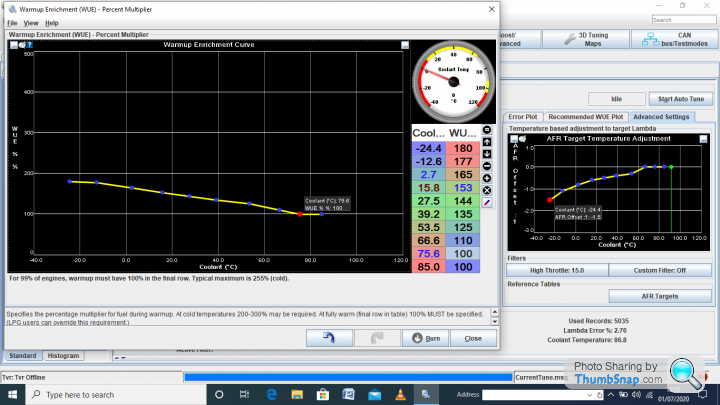
The car starts well and runs well as it starts to warm up but when i reach around 75 degrees and my enrichment ends my engine will stall.
just before it stalls i witness the Afr going lean which is telling me it needs a slightly longer enrichment.
The problem is that in cold weather the running temps may creep as low as 75 degrees, which takes me back into enrichment.
Im happy my thermostat is functioning correctly.
its probably something ive just got to live with and may happen on the 14cux.
Picture enclosed to show the enrichment curve and the settings, my idle Afr is set to around 13.5.
The graph on the right is the plot the autotune feature uses to fine tune the graph for you and seems to work well.

Dougal9887 said:
It may be that you are relying too much on warm up enrichment when the engine doesn't need it. Maybe try setting the WUE table curve to cut enrichment at about 50-60deg and adjust your VE table/throttle to idle nicely at that temp.
At 16deg my WUE% is 120 and 102 by 50deg.
Dougal.
Thanks, can you remember what your afr is doing throughout warmup?At 16deg my WUE% is 120 and 102 by 50deg.
Dougal.
This morning at roughly 10 degrees I started at 12.5 and gradually rose to my idle afr of 13.8.
Escy said:
Sounds like a very rich idle. What happens if you give it 14.7?
If it was me I'd change the thermostat for one that opens later, you want the coolant to be sitting at 90 degrees when warmed up.
Today I was running at 85 degrees on a run, I have changed over to the different temp sender talked about on the forum, I'm now wondering is it adding to the confusion. If it was me I'd change the thermostat for one that opens later, you want the coolant to be sitting at 90 degrees when warmed up.
The gauge and megasquirt readings do match though.
The standard start opens at 88 degrees I think?
Mine certainly seems to when monitoring warm up.
Edited by Belle427 on Wednesday 1st July 20:35
Its important to remember warm up enrichment is a multiplication of your main fuel table, when you drop out of warm up enrichment you immediately fall back on the idle cells within that main fuel table. By the sound of it you could do with enriching your main fuel table rather than focusing on your warm up enrichment, try coming out of cold start enrichment earlier, say 60c, then enriching your idle cells in your fuel table so there's no change in AFR when your warm up enrichment taper ends.
Finish the job by activating closed loop at 70c to correct what will likely be an idle that's naturally a little rich in open loop, allow closed loop to lean out the open loop idle AFR, using closed loop to lean out a rich fuel table always works better than using it to enrichen a table that's lean in open loop. Its also helpful to configure your wide band closed loop to be slower responding than you might first assume, try 'check every 1.0 second' and gradually speed it up from there, you will probably find it is not beneficial to go any faster than 0.75 seconds.
A rich fuel table that's slowly corrected by a lazier acting closed loop strategy will give you better part throttle transients and tip in because the natural condition will be a rich one before closed loop catches up, it will also mean you're falling back in a nice rich bed of fuel when you snap lift off the throttle. Your return to idle as you snap lift off/brake approaching junctions will deliver a smother transition. Like this you should see a momentary rich spike when the throttle snaps shut which is exactly what you want, then in the first second or less of idle you should also see closed loop leaning the engine out to your chosen idle AFR, I recommend this should be no leaner than 13.8:1.
Finally to add further polish and ensure your snap returns to idle never dip more than 50rpm below your target idle speed use spark scatter to add timing beneath your idle target, this feature is also extremely useful to pull timing from a base idle setting you've set at 100 to 150rpm higher than your spark scatter closed loop idle target. Much as closed loop lambda AFR is not immediate, closed loop idle using ignition timing should be set quite slow acting too, the end result of both strategies correctly configured and working in harmony should be you need less extra air from your idle control valve during warm up which is a good thing. It should also deliver OEM levels of warm up enrichment, warm up idle speed, the transition from warm up enrichment to running temp and with good idle stability, acceleration transients, and overall drivability.
Finish the job by activating closed loop at 70c to correct what will likely be an idle that's naturally a little rich in open loop, allow closed loop to lean out the open loop idle AFR, using closed loop to lean out a rich fuel table always works better than using it to enrichen a table that's lean in open loop. Its also helpful to configure your wide band closed loop to be slower responding than you might first assume, try 'check every 1.0 second' and gradually speed it up from there, you will probably find it is not beneficial to go any faster than 0.75 seconds.
A rich fuel table that's slowly corrected by a lazier acting closed loop strategy will give you better part throttle transients and tip in because the natural condition will be a rich one before closed loop catches up, it will also mean you're falling back in a nice rich bed of fuel when you snap lift off the throttle. Your return to idle as you snap lift off/brake approaching junctions will deliver a smother transition. Like this you should see a momentary rich spike when the throttle snaps shut which is exactly what you want, then in the first second or less of idle you should also see closed loop leaning the engine out to your chosen idle AFR, I recommend this should be no leaner than 13.8:1.
Finally to add further polish and ensure your snap returns to idle never dip more than 50rpm below your target idle speed use spark scatter to add timing beneath your idle target, this feature is also extremely useful to pull timing from a base idle setting you've set at 100 to 150rpm higher than your spark scatter closed loop idle target. Much as closed loop lambda AFR is not immediate, closed loop idle using ignition timing should be set quite slow acting too, the end result of both strategies correctly configured and working in harmony should be you need less extra air from your idle control valve during warm up which is a good thing. It should also deliver OEM levels of warm up enrichment, warm up idle speed, the transition from warm up enrichment to running temp and with good idle stability, acceleration transients, and overall drivability.
ChimpOnGas said:
Its important to remember warm up enrichment is a multiplication of your main fuel table, when you drop out of warm up enrichment you immediately fall back on the idle cells within that main fuel table. By the sound of it you could do with enriching your main fuel table rather than focusing on your warm up enrichment, try coming out of cold start enrichment earlier, say 60c, then enriching your idle cells in your fuel table so there's no change in AFR when your warm up enrichment taper ends.
Finish the job by activating closed loop at 70c to correct what will likely be an idle that's naturally a little rich in open loop, allow closed loop to lean out the open loop idle AFR, using closed loop to lean out a rich fuel table always works better than using it to enrichen a table that's lean in open loop. Its also helpful to configure your wide band closed loop to be slower responding than you might first assume, try 'check every 1.0 second' and gradually speed it up from there, you will probably find it is not beneficial to go any faster than 0.75 seconds.
A rich fuel table that's slowly corrected by a lazier acting closed loop strategy will give you better part throttle transients and tip in because the natural condition will be a rich one before closed loop catches up, it will also mean you're falling back in a nice rich bed of fuel when you snap lift off the throttle. Your return to idle as you snap lift off/brake approaching junctions will deliver a smother transition. Like this you should see a momentary rich spike when the throttle snaps shut which is exactly what you want, then in the first second or less of idle you should also see closed loop leaning the engine out to your chosen idle AFR, I recommend this should be no leaner than 13.8:1.
Finally to add further polish and ensure your snap returns to idle never dip more than 50rpm below your target idle speed use spark scatter to add timing beneath your idle target, this feature is also extremely useful to pull timing from a base idle setting you've set at 100 to 150rpm higher than your spark scatter closed loop idle target. Much as closed loop lambda AFR is not immediate, closed loop idle using ignition timing should be set quite slow acting too, the end result of both strategies correctly configured and working in harmony should be you need less extra air from your idle control valve during warm up which is a good thing. It should also deliver OEM levels of warm up enrichment, warm up idle speed, the transition from warm up enrichment to running temp and with good idle stability, acceleration transients, and overall drivability.
Very useful advice so thanks.Finish the job by activating closed loop at 70c to correct what will likely be an idle that's naturally a little rich in open loop, allow closed loop to lean out the open loop idle AFR, using closed loop to lean out a rich fuel table always works better than using it to enrichen a table that's lean in open loop. Its also helpful to configure your wide band closed loop to be slower responding than you might first assume, try 'check every 1.0 second' and gradually speed it up from there, you will probably find it is not beneficial to go any faster than 0.75 seconds.
A rich fuel table that's slowly corrected by a lazier acting closed loop strategy will give you better part throttle transients and tip in because the natural condition will be a rich one before closed loop catches up, it will also mean you're falling back in a nice rich bed of fuel when you snap lift off the throttle. Your return to idle as you snap lift off/brake approaching junctions will deliver a smother transition. Like this you should see a momentary rich spike when the throttle snaps shut which is exactly what you want, then in the first second or less of idle you should also see closed loop leaning the engine out to your chosen idle AFR, I recommend this should be no leaner than 13.8:1.
Finally to add further polish and ensure your snap returns to idle never dip more than 50rpm below your target idle speed use spark scatter to add timing beneath your idle target, this feature is also extremely useful to pull timing from a base idle setting you've set at 100 to 150rpm higher than your spark scatter closed loop idle target. Much as closed loop lambda AFR is not immediate, closed loop idle using ignition timing should be set quite slow acting too, the end result of both strategies correctly configured and working in harmony should be you need less extra air from your idle control valve during warm up which is a good thing. It should also deliver OEM levels of warm up enrichment, warm up idle speed, the transition from warm up enrichment to running temp and with good idle stability, acceleration transients, and overall drivability.
id be interested to see what numbers people are running at idle in their ve table, i understand every car is different but have always felt mine look low.
Ive currently got ego control (closed loop) not controlling my idle afr as when tested previously it made it a bit unstable so may try revisiting this.
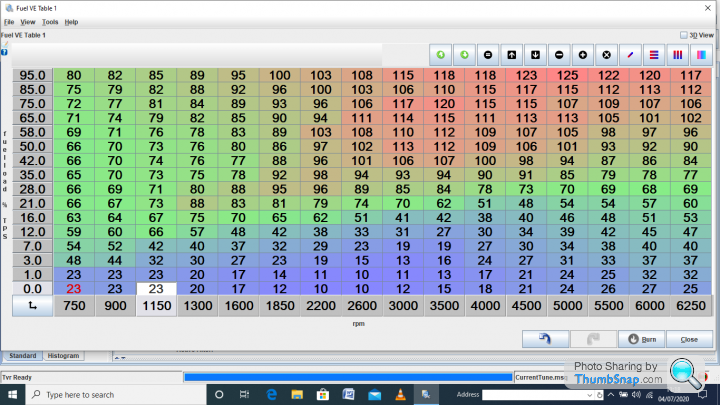
Belle427 said:
Very useful advice so thanks.
I've currently got ego control (closed loop) not controlling my idle afr as when tested previously it made it a bit unstable so may try revisiting this.
When revisiting closed loop idle try slowing down the rate of correction to remove the instability you previously experienced, the amount of correction in increments of change should also be small, I suggest running a maximum correction size of just 1% and as you'll see from the below image I've instructed closed loop to only check, and so correct, my AFR every 1.30 seconds which TBH is pretty lazy but this slow setting definitely works best.I've currently got ego control (closed loop) not controlling my idle afr as when tested previously it made it a bit unstable so may try revisiting this.
The speed of closed loop correction is critical to avoid over correction either side of your target, a setting that corrects too fast will commonly result in idle instability and hunting, slow things down and this should all disappear.
Slower is better, and less is more

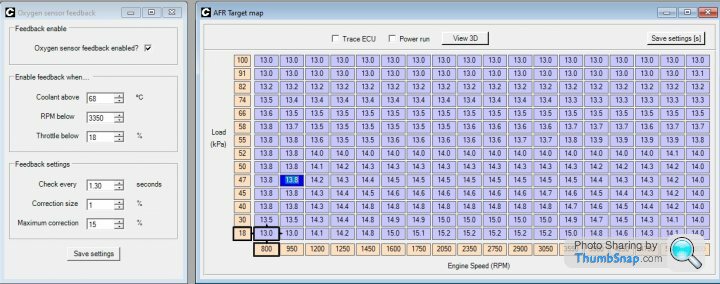
As previously stated a rich fuel table leaned by closed loop is the way forward, when idle tuning a carburetor you lean off gradually until the engine stumbles, you then enrichen very very slowly until you just reach that point where the idle become stable again. Its similar when tuning closed loop, start with a slow response time and gradually speed it up until your idle becomes unstable, then very very gradually slow it back down until you just reach that point where the idle becomes smooth again.
Like tuning a carb it is also often beneficial to go just beyond the exact point where the idle becomes smooth again, ie a little on the rich side for a carb or a little of the slow responding side when tuning idle smoothness in closed loop. Shoot for a 13.8:1 AFR idle on the old Rover V8 and no leaner, if you still can't achieve a smooth idle at 13.8:1 something else is wrong unless you're running a lot of valve overlap ie an aggressive cam profile.
Finally keep in mid idle tuning is a balancing act, you are looking to balance idle ignition timing, air supplied by your idle valve, your crankcase breather setup, throttle butterfly rest gap, and your base idle screw setting at the throttle body. All tuning should be conducted with closed loop features disabled, get the engine running sweet but a little rich and fast, then use closed loop AFR correction to lean out that idle very slightly, finally use spark scatter to pull that naturally lifted idle speed back down to your chosen target.
Only activate closed loop AFR correction from 68c up or warmer, and only use the idle valve to increase idle speed during the warm up phase, its involvement should be disabled from 68c and above although you may wish to allow it to offer anti stall... but only in extreme situations. After 68c you can start to let closed loop AFR correction hit your idle AFR target and spark scatter to trim your idle speed and also support the idle valve anti stall strategy, get it all right and your idle speed should return to your target quickly without dropping more than 50rpm below it when you snap lift off and brake approaching a junction, your engine should then settle immediately to a stable smooth 'drum roll' idle and never go leaner than 13.8:1.
If your spark scatter is calibrated correctly this smooth 'drum roll' idle may occur and significantly different timing numbers depending on coolant/engine temp, atmospheric or other conditions such as the additional load placed on the idling engine when the radiator fans chime in or you put your steering in full lock, assuming of course you have power steering that is. The system should respond quickly enough to hold the idle at the target without over correcting on fan activation, you can make your life even easier in this respect by running a staged fan setup, I went with a Davies Craig fan controller that does this job beautifully for just £45.
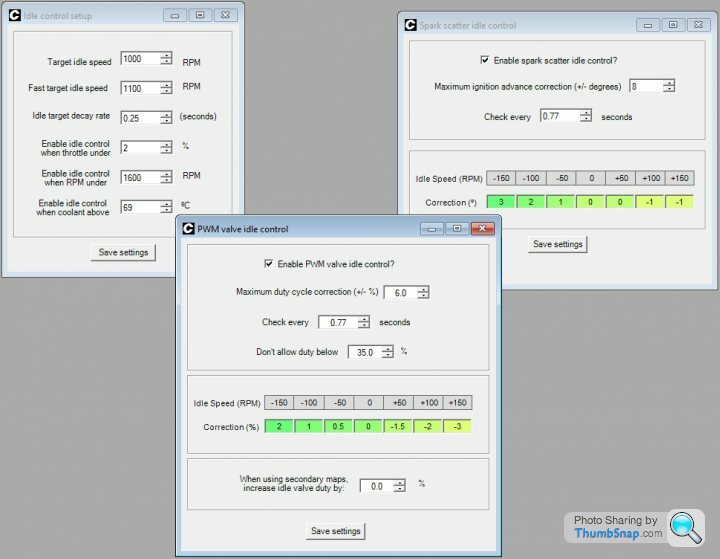
Despite both idle valve and spark scatter closed loop idle features having the same correction speed setting of 0.77 seconds the reality is adjusting idle speed using ignition timing is faster, more accurate and offers much better stability than if you try to manage idle speed using air (the idle valve). Spark scatter therefore becomes the primary closed loop idle strategy, with the idle valve just being there for warm up duty and to support under extreme situations such as a stall. The quality of the idle valve is also critical as there's some real junk out there, these can give all sorts of trouble and have you chasing your tail.
Its probably best not to ask me how I know this
 .
.Only use a genuine Bosch item or those from Lowe which are quality German made idle valves I've had great success with, Lowe valves offer a significant saving over the Bosch original but will work perfectly; unlike the dreadful no name rubbish that was originally supplied with my Canems system

I hope this helps?
Happy tuning

yes ive currently disabled the idle valve above 70 degrees, ive set the idle speed via the throttle stop screw and closed down the idle by pass screw.
Ive found the engine is more stable without input from it after warm up.
Unfortunately Megasquirt does not have the scatter spark feature.
Ive found the engine is more stable without input from it after warm up.
Unfortunately Megasquirt does not have the scatter spark feature.
Edited by Belle427 on Saturday 4th July 14:43
Belle427 said:
yes ive currently disabled the idle valve above 70 degrees, ive set the idle speed via the throttle stop screw and closed down the idle by pass screw.
Ive found the engine is more stable without input from it after warm up.
Sounds like you're on it Ive found the engine is more stable without input from it after warm up.

Whats always amazed me is just how smooth a well set up 14CUX will idle at 14.7:1, this proves this rather ancient and crude engine can be happy idling at stoich but I've never been 100% happy with it, don't get me wrong I can idle at 14.7:1, its just my engine is noticeably smoother at 13.8:1.
I guess the real difference is with the 14CUX you're suck at stoich so there's no seeing how much smoother it could be if you ran it a little richer, anyway the fuel economy difference is minuscule, the only reason you'd run 14.7:1 is to lower emissions and if I was worried about that I wouldn't have entirely de-catted the car.
My only other observation is my engine definitely idles smoother on gas, don't get me wrong its smooth on petrol, just even smoother on LPG which I attribute to the fuel mixing better with air. Saying that I have a set of four port petrol Bosch 0 280 156 045 injectors to fit which at my new 20% higher fuel pressure will be sure to deliver better fuel atomization, by replacing the old stock FPR with one from an early/mid 90's BMW 3 series my fuel pressure went up from 37psi to 44psi, well worth the £28.00 this new direct fit reg cost me.
https://www.ebay.co.uk/itm/Fuel-Pressure-Sensor-FD...
Increasing the fuel pressure by 20% and forcing the fuel at 44psi through the four tiny ports used on the superior Bosch 0 280 156 045 injectors will for sure deliver improved emulsification of petrol and air compared with my old two port Vecra injectors running at 37psi, this should improve cold starts too and serve to redress the balance between my petrol & LPG idle quality.
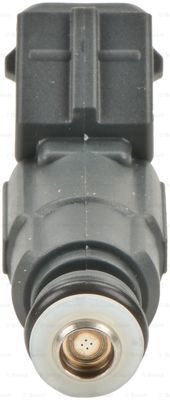
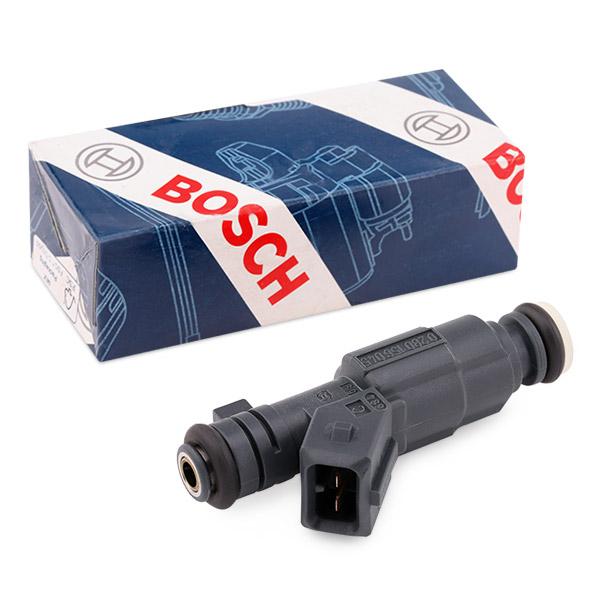
As you can probably tell I'm somewhat obsessive about how my TVR idles and runs

QBee said:
You mentioned that you thought the new temp gauge sender could be causing the problem (but also said its readings matched the ECU's).
Dave will correct me if I am wrong, but I thought the ECU got its temperature readings independently of the temperature gauge sender?
Yes it does, I was not thinking straight.Dave will correct me if I am wrong, but I thought the ECU got its temperature readings independently of the temperature gauge sender?
ChimpOnGas said:
Sounds like you're on it 
Whats always amazed me is just how smooth a well set up 14CUX will idle at 14.7:1, this proves this rather ancient and crude engine can be happy idling at stoich but I've never been 100% happy with it, don't get me wrong I can idle at 14.7:1, its just my engine is noticeably smoother at 13.8:1.
I guess the real difference is with the 14CUX you're suck at stoich so there's no seeing how much smoother it could be if you ran it a little richer, anyway the fuel economy difference is minuscule, the only reason you'd run 14.7:1 is to lower emissions and if I was worried about that I wouldn't have entirely de-catted the car.
My only other observation is my engine definitely idles smoother on gas, don't get me wrong its smooth on petrol, just even smoother on LPG which I attribute to the fuel mixing better with air. Saying that I have a set of four port petrol Bosch 0 280 156 045 injectors to fit which at my new 20% higher fuel pressure will be sure to deliver better fuel atomization, by replacing the old stock FPR with one from an early/mid 90's BMW 3 series my fuel pressure went up from 37psi to 44psi, well worth the £28.00 this new direct fit reg cost me.
https://www.ebay.co.uk/itm/Fuel-Pressure-Sensor-FD...
Increasing the fuel pressure by 20% and forcing the fuel at 44psi through the four tiny ports used on the superior Bosch 0 280 156 045 injectors will for sure deliver improved emulsification of petrol and air compared with my old two port Vecra injectors running at 37psi, this should improve cold starts too and serve to redress the balance between my petrol & LPG idle quality.


As you can probably tell I'm somewhat obsessive about how my TVR idles and runs
Hi, what is the coil set up on these systems are they generic or bespoke to the system. And are they fired conventionally ie switched by earth only? 
Whats always amazed me is just how smooth a well set up 14CUX will idle at 14.7:1, this proves this rather ancient and crude engine can be happy idling at stoich but I've never been 100% happy with it, don't get me wrong I can idle at 14.7:1, its just my engine is noticeably smoother at 13.8:1.
I guess the real difference is with the 14CUX you're suck at stoich so there's no seeing how much smoother it could be if you ran it a little richer, anyway the fuel economy difference is minuscule, the only reason you'd run 14.7:1 is to lower emissions and if I was worried about that I wouldn't have entirely de-catted the car.
My only other observation is my engine definitely idles smoother on gas, don't get me wrong its smooth on petrol, just even smoother on LPG which I attribute to the fuel mixing better with air. Saying that I have a set of four port petrol Bosch 0 280 156 045 injectors to fit which at my new 20% higher fuel pressure will be sure to deliver better fuel atomization, by replacing the old stock FPR with one from an early/mid 90's BMW 3 series my fuel pressure went up from 37psi to 44psi, well worth the £28.00 this new direct fit reg cost me.
https://www.ebay.co.uk/itm/Fuel-Pressure-Sensor-FD...
Increasing the fuel pressure by 20% and forcing the fuel at 44psi through the four tiny ports used on the superior Bosch 0 280 156 045 injectors will for sure deliver improved emulsification of petrol and air compared with my old two port Vecra injectors running at 37psi, this should improve cold starts too and serve to redress the balance between my petrol & LPG idle quality.


As you can probably tell I'm somewhat obsessive about how my TVR idles and runs

Gassing Station | Chimaera | Top of Page | What's New | My Stuff




